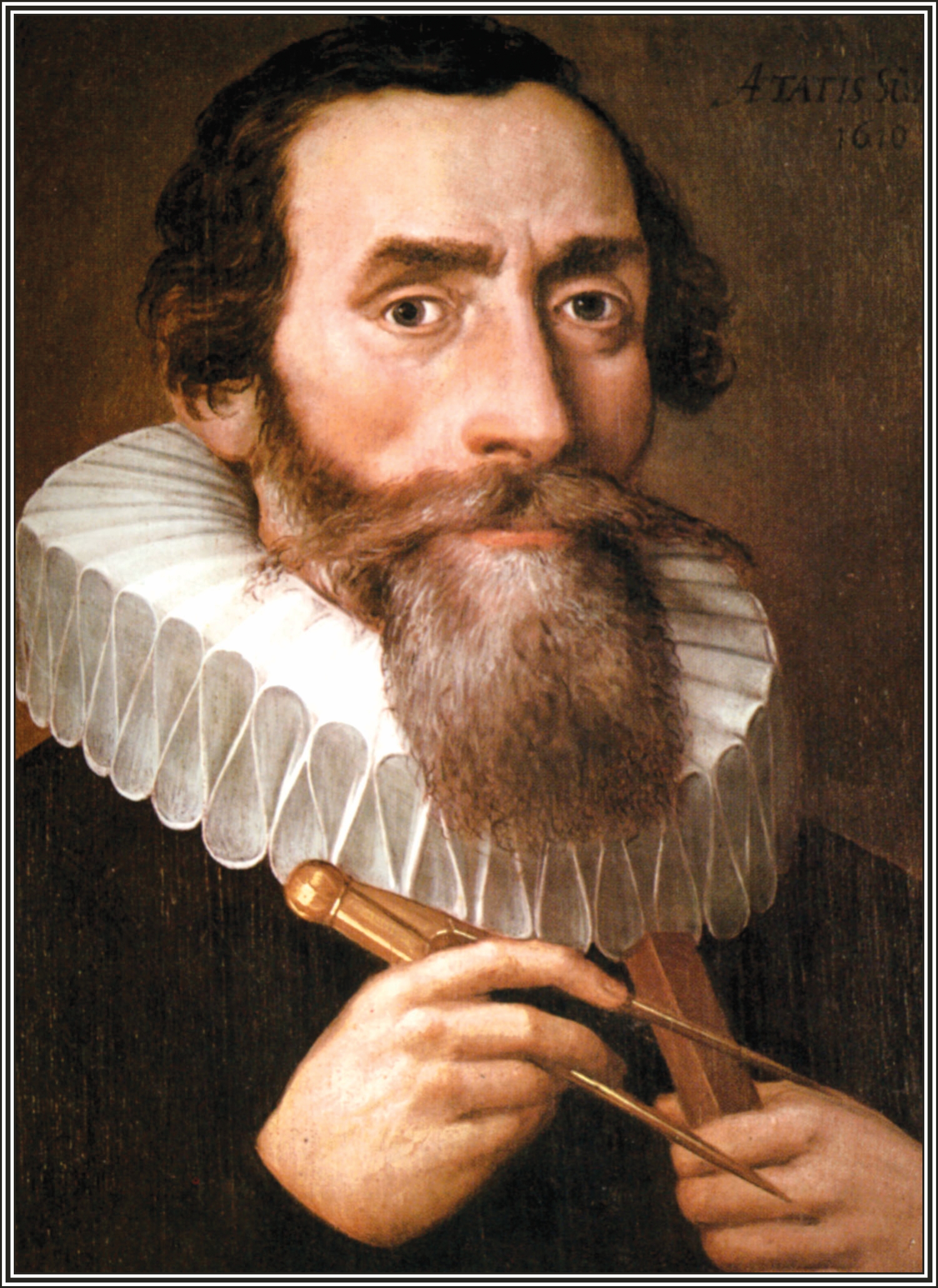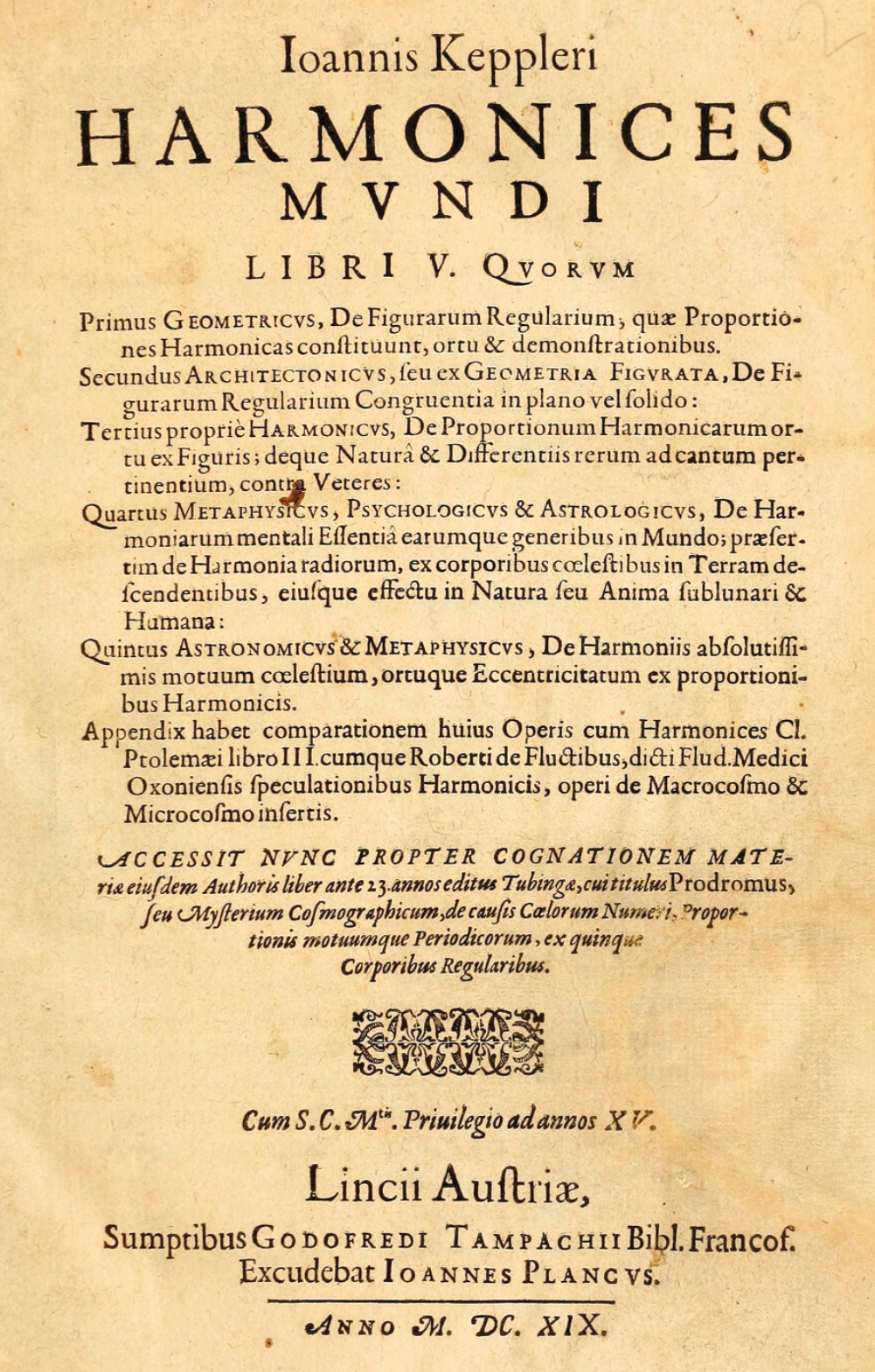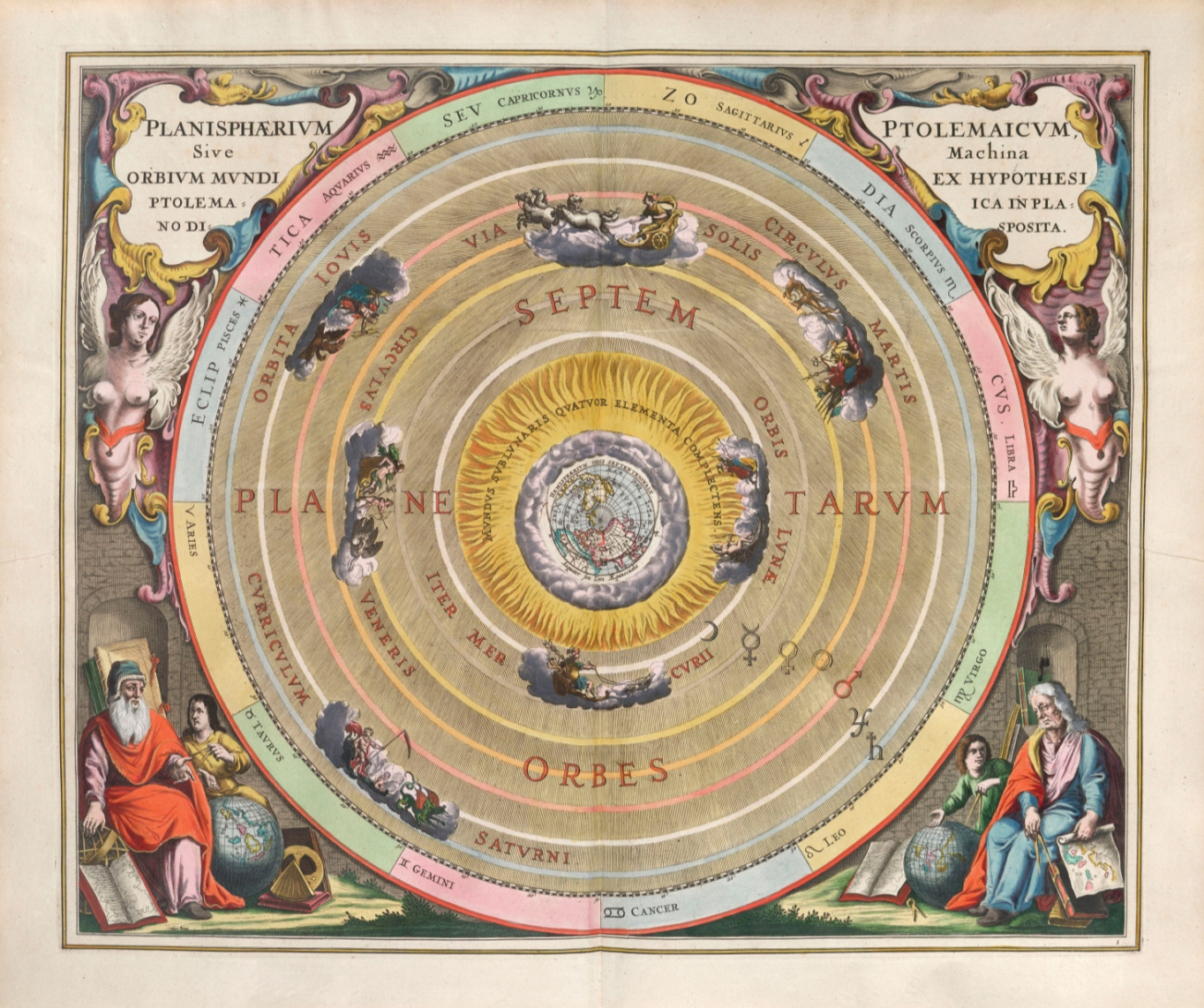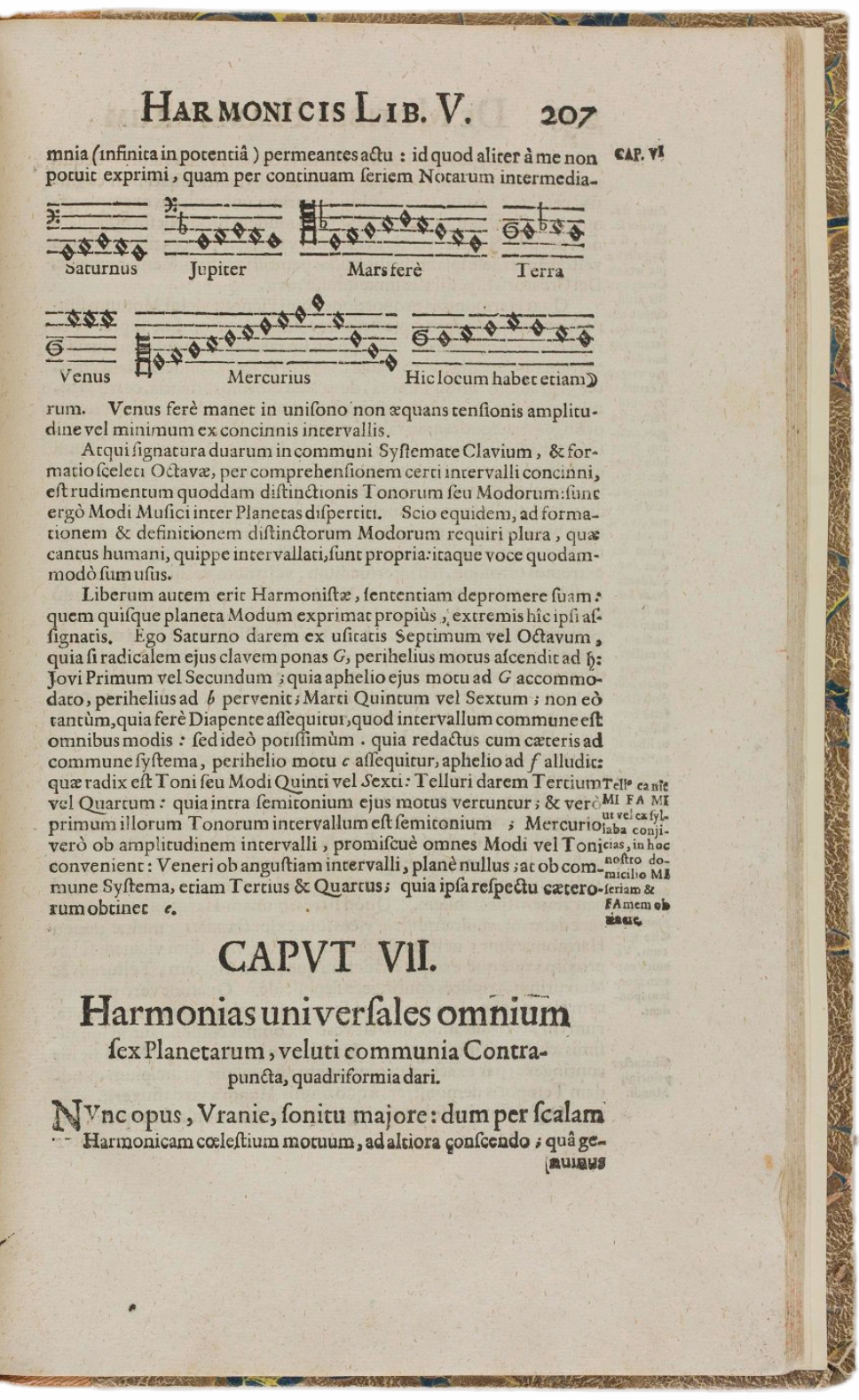Johannes Kepler’s pursuit of harmony
DOI: 10.1063/PT.3.4388
Most people who have heard of Johannes Kepler,

Portrait of Johannes Kepler (1571–1630), painted in 1610. (Unknown artist, via Wikimedia Commons, PD-US.)

But Kepler did not view astronomy as his highest calling. In a letter from 1605, written only a few weeks after he formulated his theory of elliptical orbits—following a careful study of the orbit of Mars—he wrote the following to a friend in London: “If only God would set me free from astronomy so that I might turn to the care of my work on the harmony of the world.”
1
Kepler was referring not only to the work that would become his 1619 masterpiece The Harmony of the World (see figure
Figure 1.

The opening page of Harmonices Mundi (The Harmony of the World) by Johannes Kepler, from the original 1619 printing. (From the Posner Family Collection, Carnegie Mellon University Libraries, PD-US.)

Kepler devoted his life to the cause of harmony; it was both the intellectual bedrock for and the crucial goal of his seemingly disparate endeavors. To Kepler, the quest was not merely academic or theoretical. The world in which he lived was beset by overwhelming discord as the Holy Roman Empire moved ever closer to a devastating religious and civil war. The spark that finally ignited the conflict was the famous 1618 defenestration of Prague, in which aggrieved Protestants threw two Catholic bureaucrats and their unfortunate secretary from a third-story window. That incident took place a mere four days before Kepler completed his Harmony of the World, and the war the incident began would ultimately wipe out one-third of Germany’s population.
Yet Kepler persisted in pursuing his goal of harmony through the discordant havoc of war, exile, his excommunication from the Lutheran Church, and a great deal of personal loss and hardship. His ultimate goal was both to reveal the harmony in nature and to work toward a worldly harmony that might follow from it. Although Kepler’s ideas about what might constitute earthly harmony changed over time, he ultimately came to believe that following God’s harmonic model in the heavens meant accepting the peaceful coexistence of diverse religious views on Earth.
Kepler the astronomer–priest
The fact that Kepler doesn’t seem to have wanted to spend the majority of his time on the things that made him famous is representative of the trouble we moderns have had both in understanding him and in understanding premodern science more generally. Kepler had varied interests, from astrology and music to politics and chronology, and he wrote a great deal on many subjects, from short works on snowflakes and trips to the Moon to long pamphlets on theology. Even though he spent so much time developing precise astronomical calculations based on observation—the kind of thing people today want to see as representative of the scientific enterprise—his eclectic interests have made it difficult to fit him into traditional stories of the history of science, which describe a progressive move away from ungrounded and inaccurate speculation toward objectivity and precision.
Then comes Kepler’s strange relationship with the churches of his day. Kepler was raised as a Lutheran, studied theology in the seminary at Tübingen, and hoped to become a priest. That plan did not happen. Instead, he was sent to serve as a teacher of mathematics at the Lutheran high school in Graz. When he was expelled from the Catholic city along with its other Lutheran residents, he moved to Prague to work under Tycho Brahe, famed astronomer and imperial mathematician to the Holy Roman Emperor. Ultimately, Kepler rose to become imperial mathematician upon Tycho’s death. Despite his move away from the priesthood, he continued to care about theological questions, write about theological issues, and frame his pursuits theologically. He was, in his own words, an “astronomer–priest” who unveiled the book of nature for its readers. 2
Kepler also continued to identify as a Lutheran even though he was excommunicated from the church in 1619. His excommunication was the result of a disagreement about the Lutheran approach to communion, the ritual in which the presence of Christ’s body and blood is celebrated by consuming sacramental bread and wine. Historians have largely ignored the reasons for Kepler’s excommunication, perhaps because Galileo Galilei’s famous trial over heliocentrism has made it easy to assume that Kepler’s excommunication was rooted in similar causes. In the famous A History of the Warfare of Science with Theology in Christendom, Andrew Dickson White positioned Kepler alongside Galileo as a warrior in the battle of science against religion. 3
That story is utterly wrong, and not just because Kepler’s excommunication happened for reasons unrelated to his heliocentrism. It’s wrong because it doesn’t take seriously what Kepler understood himself to be doing or how his work fits into the bigger religious, cultural, and intellectual landscape of 16th- and 17th-century Europe. More recent histories of science and religion have emphasized the ways that religious thought was integral to the scientific work of many luminaries of the scientific revolution. 4
Kepler himself has yet to be fully placed into that revised picture. 5 That is unfortunate, because he provides us with an important lens onto the intersections of science, religion, and politics at the moment when modern science is said to have been born. That perspective helps us understand his world in new and important ways. So let us take seriously what Kepler says and think about what he thought he was doing and why he placed such value on his work on harmony.
The harmonic tradition
To understand what harmony meant to Kepler, we need to review a longer history of the concept. 6 That intellectual tradition can be traced back to the Greek mathematician Pythagoras, who supposedly passed a blacksmith’s shop one day and discovered that hammers of different weights produced different sounds, some consonant in combination and some dissonant. As he later determined by experimenting with strings and their pitches, the reason for those differences lay in the numerical relationship between the various weights or lengths of string. Musical harmony could thus be linked directly to ordered numerical relationships.
Although the Pythagoras of legend discovered the theory of harmony empirically, ancient theorists insisted that the mathematical relationships governing harmony could be determined a priori. Plato linked that vision of harmony to the cosmos. In his Timaeus, he described a cosmos whose interplanetary distances could be represented on a musical scale and whose planetary motions produced beautiful harmonies that were orchestrated by their creator much as a musician played his instrument.
The medieval theory of music, drawing from the work of the sixth-century Roman philosopher Boethius, underscored the idea of a mathematical link between music and the heavens. Medieval theory divided seven liberal arts into the trivium—grammar, logic, and rhetoric—and the quadrivium—arithmetic, geometry, astronomy, and music. That division established music as a science rather than an aesthetic taste or skill. Boethius also famously identified three types of music: musica instrumentalis, which encompassed singing and instrumental performance; musica humana, the music of the body and soul; and musica mundana, the music of the spheres.
Harmony was both mathematical and moral; it linked music not only to the ordering of the cosmos but also to the ordering of human society. Plato made that linkage clear by ending his Republic, a vision of the ideal state, with the Myth of Er, a vision of the musical cosmos. Though harmony might embrace differences, only certain combinations of an otherwise discordant jumble of conflicting elements could be allowed. In the Republic, Plato forbade all innovation in music because it would inevitably alter the foundations of political society. The Roman statesman Cicero also linked the well-ordered state with the notion of harmony. He suggested that the beauty of the state, like the beauty of music, lay in a clear, hierarchical division of the individual elements that composed it and could brook no modifications that would upset that order.
Similar ideas of harmony and hierarchy were extended later to the Catholic Church. In the 13th century, Thomas Aquinas wrote that the pope, like the king in a polity, sat on the highest rung of the churchly hierarchy. All steps of the hierarchy, from the priesthood down to the laity, were necessary in order to preserve its harmonious status.
The Eucharist, the sacrament of communion, represented communal harmony. Taking communion was not only a way to experience the miracle of God’s presence; it was also a ritual of social unity, a way to signal one’s membership in the community. Refusing to partake in the communion implied communal discord. Thus some parishioners refused to take the communion if they were in the midst of a dispute with a fellow community member. When a member deliberately broke ties with the rest of the community and engaged in sin, they were excommunicated—literally, denied the ability to partake of the communion and thus cast out of the larger community.
After the Reformation, notions of what constituted proper hierarchy and proper communal harmony differed from confession to confession. Communion continued to signify communal harmony and belonging, but it also became a primary sign of proper belonging. In an era of religious warfare, it was imperative not to partake of the communion alongside heretics. To do so would be to signal approval of their blasphemous beliefs and to threaten the harmony that united the community of true believers.
Changes in the harmonic ideal
The move to a heliocentric cosmos shook the foundations of the harmonic tradition, which was anchored firmly to the geocentric Ptolemaic cosmos. That cosmos was organized in a clear hierarchical chain, shown in figure
Figure 2.

A 17th-century drawing of the Ptolemaic cosmos. Earth lies at the center of the system; the Sun and the planets, represented here as their namesake Roman gods, orbit Earth; the stars sit in the outermost sphere. (From Harmonia macrocosmica, 1661, Andreas Cellarius, PD-US.)

Although the move to a Sun-centered cosmos seemed to some to threaten the idea of cosmic harmony, Copernicus relied on the language of harmony to argue for the superiority of heliocentrism. As he explained in the introduction to his De revolutionibus, the profusion of eccentrics, epicycles, and equants in the Ptolemaic system “was just like someone taking from various places hands, feet, a head, and other pieces…. Since these fragments would not belong to one another at all, a monster rather than a man would be put together from them.” Copernicus argued that his system, in contrast, was harmonious because in it “heaven itself is so linked together that in no portion of it can anything be shifted without disrupting the remaining parts and the universe as a whole.” 8
Similarly, 16th-century astronomer Rheticus insisted that the Copernican cosmos was more harmonious than the older world system. Rheticus argued that earlier astronomers would have had better luck had they more closely “imitate[d] the musicians who, when one string has either tightened or loosened, with great care and skill regulate and adjust the tones of all the other strings, until all together produce the desired harmony, and no dissonance is heard in any.” 9
Copernicus and Rheticus appealed to harmony in abstract and largely rhetorical ways. Kepler, however, regarded rescuing the theory of harmony in a post-Copernican cosmos as a central task of The Harmony of the World. He sought to describe new planetary intervals that would yield harmonious proportions when the Sun, rather than Earth, lay at the center. To do that, Kepler relied on two factors that he believed distinguished modern harmonies from ancient ones: polyphony, or music with independent melodies or voices that harmonize together, and just intonation, in which thirds and sixths are consonant.
Kepler was fluent in the musical theory of his day; he had read the works of 16th-century composer and theorist Gioseffo Zarlino and music theorist Sethus Calvisius, whom he cited as an authority in The Harmony of the World. 10 Pythagorean theories of harmony insisted that all harmonious intervals had to be formed from ratios of the tetrad, the numbers one through four; that excluded thirds and sixths, whose ratios relied on the number five. But Kepler believed that a theory of music that excluded thirds and sixths was untenable. The problem with earlier approaches to music, he argued in The Harmony of the World, was that the Pythagoreans had trusted philosophy and abstract numbers over the judgment of their ears.
Kepler, by contrast, followed those who hoped to establish a theory of harmony that, while rooted in mathematics, would also sound good to the listener by including thirds and sixths. That was especially important for Kepler because without a system of intonation that allowed for thirds and sixths, true polyphony was impossible. And in Kepler’s view it was polyphony, above all, that distinguished the superiority of modern music. He argued that only in polyphonic music can man finally imitate true cosmic harmonies.
Kepler ultimately developed a new geometrical system—in contrast to the arithmetical system of the Pythagoreans—for grounding the harmonies. He linked that geometrical system not to the distances between planets, which is how planetary harmony had been understood up until that point, but to their speeds—in particular, their angular velocities with reference to the Sun at the moments of perihelion and aphelion. Those speeds determined the scale of each planet by demarcating their highest and lowest notes (see figure
Figure 3.

Kepler’s musical scales for the six known planets: Saturn, Jupiter, Mars, Earth, Venus, and Mercury. The final scale represents the Moon; hic locum habet etiam translates to “here the moon also has a place.” The highest and lowest notes of each planetary scale are determined by the planet’s angular velocity with reference to the Sun at the moments of perihelion and aphelion. (From Johannes Kepler, Harmonices Mundi, 1619, Posner Family Collection, Carnegie Mellon University Libraries, PD-US.)

One implication of that approach to cosmic harmony was that the actual sounds produced by the planetary motions were, on the whole, dissonant. But the musical theory of Kepler’s day had increasingly embraced dissonance as an essential contribution to the beauty of the overall harmony. Kepler compared the use of dissonance in musical harmony to the use of yeast, salt, or vinegar in cooking; although complete dishes aren’t made from those ingredients, they are still used to great effect. Furthermore, given the specific intervals produced by each planet, moments of harmonic consonance between the majority of them would be incredibly rare. According to Kepler, the planets all played a perfect harmony at the very moment of Creation, and they might play one again at the end of days. Before then, large-scale dissonance and smaller harmonies were all that could be expected.
Social harmonies
Kepler’s understanding of harmony had components that were either absent or undervalued in most theories of harmony before the 16th and 17th centuries—namely polyphony and dissonance. He emphasized in the opening of The Harmony of the World that his new vision might yield important insights for those who hoped to achieve harmony of church and state. What kind of social insights, then, followed from Kepler’s vision of harmony?
In contrast to earlier thinkers who linked social harmony with hierarchy and conformity, Kepler extended his ideas to society by embracing a vision that valued diversity over homogeneous unity. When it came to music, he argued that “the harmonious singing of parts … without any variety in them, ceases to be pleasing altogether.” 11 He invoked that notion of harmony when articulating an ecumenical vision of a religious community that embraced diversity and disagreement in its midst. Just as music was only harmonious if it contained many different notes, earthly communities, Kepler believed, needed to create a kind of cohesiveness that embraced difference.
The reunified Christendom that Kepler hoped to help create was not, in his view, to be identified with any one confession, not even his own. Rather, Kepler’s harmonious social order would embrace all confessions. It would offer some common ground on which everyone could agree and yet also allow for the fact that nobody would be able to agree on everything, particularly when it came to questions of theology.
As an example of harmonious social order that embraced multiple religious views, Kepler argued that as a believing Lutheran he should be allowed to partake of the Catholic communion. He felt that members of different denominations could take communion together so long as they agreed on the general intention of the ritual, if not its specific theological meaning. Communion would become not a sign of agreement to a particular type of community—as it had been before—but a sign of agreement for a new, more expansive vision of Christian community that embraced all denominations equally and allowed for dissent and plurality of opinion.
Significantly, his excommunication from the Lutheran Church was linked to his unorthodox position on the sacrament of communion. Catholics and Lutherans believed that the presence of Christ in the Mass was both real and physical; Calvinists believed that that presence was real but spiritual. Kepler, who disagreed with the physical implications of the Lutheran conception, felt that the Calvinists had come closest to the truth.
Kepler believed that allowing for dissent was important because God’s community included all of Christendom, Catholics and Protestants alike. No one religious community could have a monopoly on the truth, and partisan exclusivity was a destructive force. “I am pleased either by all three parties, or at least by two of them against the third, in the hopes of agreement,” he wrote in his 1623 Confession of Faith, a small published pamphlet in which he described his religious views. “But my opponents are only pleased by one party, imagining eternal irreconcilable division and quarrel. My hope, so help me God, is a Christian one; theirs, I do not know what.” 12
Kepler extended the idea of accepting dissent to other instances as well, like the battles between Catholics and Protestants over Pope Gregory XIII’s calendar reforms of 1582. There, too, his goal was to find points of commonality on which Catholics and Protestants might unite harmoniously even though they were still committed to their particular doctrines, practices, and even calendars. After all, as Kepler argued, “Christ the Lord neither was nor is Lutheran, nor Calvinist, nor Papist.” 13
Kepler’s attitude toward scientific truth differed from his attitude toward religious truth. The history of astronomy, he believed, revealed clear progress over time and showed that mathematics and cosmology were realms in which certainty, and hence unanimity, were theoretically possible. The history of the church, however, revealed the opposite—dissension only increased over time. In arguing for churchly unity, he therefore emphasized peace and harmony rather than complete agreement, and he pointed to the harmony of the cosmos as a model.
In his scientific work, he portrayed himself as an astronomer–priest, aligning himself with a theology independent of religious strife. Astronomy was a way to reveal God’s hand in the world, one that had some hope of offering universal truths on which anyone could agree.
An unrealized vision
Kepler hoped that in his lifetime he might see a world that followed the model of cosmic harmony. Instead, he saw the opposite—Europe torn apart by the most brutal war it had ever seen. Yet Kepler’s vision is worth embracing—in its hopefulness, its inclusiveness, and its recognition that a community can both disagree and remain united. Kepler himself drew hope from his conception of the origins of harmony. He believed harmony was buried deep within every one of us; eventually, it would work its way out.
In The Harmony of the World, Kepler reminded his readers that although the cosmos itself had once produced a perfect and complete harmony, it would not do so again until the end of days—and maybe not even then. God, it seemed, had meant for humans to be satisfied with the beauty of the smaller harmonies produced by individual groups of planets and to accommodate themselves to the dissonance of the whole. Even in that dissonance, they might find beauty.
Kepler ultimately agreed with the poet Alexander Pope, who a century after him thought harmony pointed a way to a world that might be improved by difference. In Pope’s words, such a world would be “Not Chaos-like together crush’d and bruis’d, / But, as the world, harmoniously confus’d: / Where order in variety we see, / And where, tho’ all things differ, all agree.” 14
This article was adapted from my book The Pursuit of Harmony: Kepler on Cosmos, Confession, and Community (University of Chicago Press, 2017).
References
1. J. Kepler, Johannes Kepler Gesammelte Werke (Collected Works of Johannes Kepler), C. H. Beck (1937–), vol. 15, letter 357.
2. Ref. 1, vol. 13, letter 91.
3. A. D. White, A History of the Warfare of Science with Theology in Christendom, vol. 1, Appleton (1896), p. 153.
4. See, for example, M. J. Osler, Reconfiguring the World: Nature, God, and Human Understanding from the Middle Ages to Early Modern Europe, Johns Hopkins U. Press (2010);
S. Shapin, The Scientific Revolution, U. Chicago Press (1996).5. See, for example, M. Caspar, Kepler, C. D. Hellman, trans., ed., Dover (1993);
R. Chen-Morris, Measuring Shadows: Kepler’s Optics of Invisibility, Pennsylvania State U. Press (2016);
P. J. Boner, Kepler’s Cosmological Synthesis: Astrology, Mechanism and the Soul, Brill (2013);
U. Rublack, The Astronomer and the Witch: Johannes Kepler’s Fight for His Mother, Oxford U. Press (2015).6. L. Spitzer, Classical and Christian Ideas of World Harmony: Prolegomena to an Interpretation of the Word “Stimmung,” A. Granville, ed., Johns Hopkins U. Press (1963).
7. J. Donne, The Complete English Poems, A. J. Smith, ed., Penguin (1971), p. 276.
8. N. Copernicus, On the Revolutions, J. Dobrzycki, ed., E. Rosen, trans., Johns Hopkins U. Press (1978), p. 4;
originally published as N. Copernicus, De revolutionibus orbium coelestium, Johannes Petreius (1543).9. D. Danielson, The First Copernican: Georg Joachim Rheticus and the Rise of the Copernican Revolution, Walker (2006), p. 75.
10. D. P. Walker, J. Warburg Courtauld Inst. 30, 228 (1967). https://doi.org/10.2307/750744
11. J. Kepler, The Harmony of the World, E. J. Aiton, A. M. Duncan, J. V. Field, trans., American Philosophical Society (1997), p. 252.
12. Ref. 1, vol. 12, p. 27.
13. Ref. 1, vol. 12, p. 29.
14. A. Pope, The Works of Alexander Pope, vol. 1, J. Balfour (1764), p. 48.
More about the Authors
Aviva Rothman is an assistant professor of history at Case Western Reserve University in Cleveland, Ohio.

